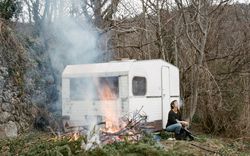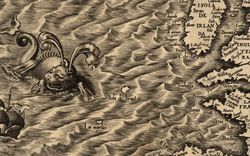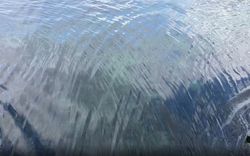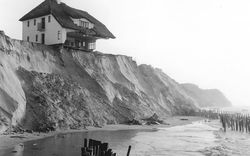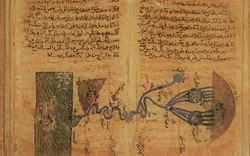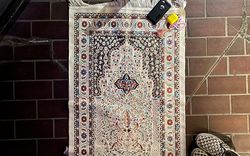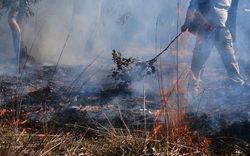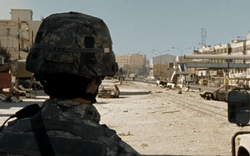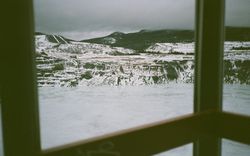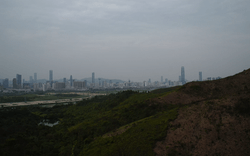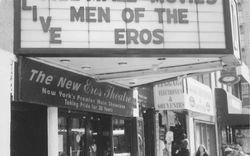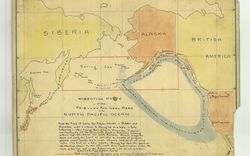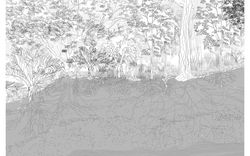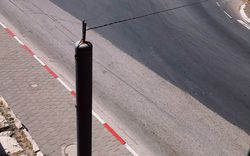Free Space
Chanelle Adams offers a guided meditation
Through breathwork and gentle instruction, this sonic essay considers the genre of guided meditations as a cartographic technology with the potential to tend to relationality across time and space—figuring territory beyond our “narrative habits”1 of terrestrial bias, alienation, and separation.
-
We are what Wynter terms “homo narrans” [Sylvia Wynter and Katherine McKittrick, “Unparalleled Catastrophe,” in Katherine McKittrick, Sylvia Wynter: on Being Human as Praxis (Durham: Duke University Press, 2015), 24–25]; “Wynter says we are not Homo sapiens, we are Homo narrans, not the ones who know, but the ones who tell ourselves that we know. She says we therefore have the capacity to know differently. We are words made flesh. But we make words. So we can make ourselves anew,” in Alexis Pauline Gumbs, Dub: Finding Ceremony (Durham: Duke University Press), xi.; “Maybe we could practice a kind of historical art, of telling the stories otherwise, as a way of inquiring into why certain kinds of story are neglected or suppressed. The default stories selected from the combinatory of story elements may be arbitrary narrative habits.” in McKenzie Wark, Capital is Dead (London: Verso, 2019), 112. ↩





Water is the first thing in my imagination. Over the reaches of the eyes at Guaya when I was a little girl, I knew that there was still more water. All beginning in water, all ending in water. Turquoise, aquamarine, deep green, deep blue, ink blue, navy, blue-black cerulean water. . . . Water is the first thing in my memory. The sea sounded like a thousand secrets, all whispered at the same time. In the daytime it was indistinguishable to me from air. . . . The same substance that carried voices or smells, music or emotion.1
—Dionne Brand, A Map to the Door of No Return: Notes to Belonging
-
Dionne Brand, A Map to the Door of No Return: Notes to Belonging (Vintage Canada, 2002), 6. ↩
I did feel something of the experience of embodiment of water, how partially submerged in water my body remembers it is non-linear, existing as it does in multiple worlds.1
—Alexis Pauline Gumbs, “On Water, Salt, Whales, and the Black Atlantics” in epistolary conversation with Christina Sharpe
-
Alexis Pauline Gumbs, “On Water, Salt, Whales, and the Black Atlantics” in epistolary conversation with Christina Sharpe in The Funambulist, Issue 39 (January-February 2022): 21. ↩
…as I trace the shape of desire and longing
I wish I was a cartographer of dreams
but what I end up with is this stubborn question:
Should I love my heart more
because every time I miss you
that is where I find you1
—Keorapetse Kgositsile, “Letter from Havana (for Baby K)”
-
Keorapetse Kgositsile, “Letter from Havana (for Baby K),” accessed at https://www.lyrikline.org/en/poems/letter-havana-5910. ↩





Where do you go when you visualize? Does your body travel with you? Do you return to that which is familiar? Or do you find yourself amongst the unfamiliar? Do you return to the familiar and find it unfamiliar?
When envisioning an imaginary beach, do you stop to ask the ocean its name?
Mental rehearsals that imagine spaciousness—from zazen to CEO mindfulness, city planning and Google Maps directions, to speculative fiction and Afrofuturism—matter. They are material because actualized, inherited, and imagined experiences of psychogeography bear relational consequences for both future and history. Corporatized colonial iterations of guided meditations take place in an imagined non-place, detaching from the burdens of relationality as a strategy of optimization. Typically, this genre of meditation involves taking a walk down an unnamed beach (remaining silent on questions of settler colonialism, history, and land).
The ocean is not a barrier between places, but a connecting force. This work considers what different narrative technology might offer this troubling terrain of our shared aquatics and collective atmosphere.
Audio Transcript
Find your way to a comfortable position, perhaps you are seated, standing, or laying down, arriving into a position where you can feel contact with the ground for about ten minutes. Bring your awareness to these points of contact with the ground beneath you—the toe, ankle, foot, shin, seat, hips, back. Anywhere you find yourself touching the ground, sink your awareness into that point, and as you do so, allow yourself to be greeted by the ground in return. As you bring your attention to the sacred ground beneath you, you might offer an acknowledgement to the sacred and Indigenous land that carries you. Perhaps offering a breath of gratitude here.
And if it feels comfortable for you, gently guide your attention toward the breath. Without needing to change it, just noticing where it is in the body. With increased intention, noticing where the body might need more breath, offering your breath to where it needs to go in the body. Take a few breaths here noticing how your breath may shift, maybe even finding space between the inhales and exhales.
We will take a few counted breaths. We do this to slow down time, we do this so we can notice how everything can happen in its time.1
4 breaths to the count of 4 on the inhale and 4 on the exhale.
In for 1, 2, 3, 4. Out for 4, 3, 2, 1. In - 1 2 3 4. Out 4 3 2 1. In 1 2 3 4. Out 4 3 2 1. In 1234 and Out 4321. Feeling the breath in the body, as the body is being breathed.
I will be guiding you through a visualization. I remind you of the sensation of the Earth beneath you as a resource if you need to release or if you encounter anything too much to hold alone. I remind you that during this meditation you operate in choice, and that these are only suggestions.
During the meditation, you may encounter kin—people, other beings, known and unknown. And if you do, I encourage you to greet them; they are visitors, just like you.
To begin, I invite you to connect with a small body of water. Any water that is readily accessible to call to mind at this moment. Maybe there’s a glass of water, the water vapour from your breath on a cold day, the nearest river, a fire hydrant. Perhaps the closest water is the water in your body.
Imagine this body of water, this water body, and imagine one single drop of that water in your palms. What is the temperature? Colour? Is there a smell? Within this droplet of water is a whole interconnected web of memory and maps. Take a moment to admire this fine hydraulic network. Suddenly the droplet begins to roll down, dripping out of your hand and onto your feet.
That’s it, you’re entering the portal.
Now you’re wandering down a beach. Maybe you notice soothing sensations of the sun, or moon depending on the time of day, a gentle breeze, and the sand beneath your feet.
Do you know this beach? Do you remember being here? You look around you, what do you see? The land beneath you, do you know its name? Who has been here before? Who might be here now? The psychic geography figures around you as you traverse this landscape, your presence becomes placed. Allow a moment here for that calibration.
Before you is a great body of salt water. This water, do you know its name? Invite in the possibility that you may know this place well, or maybe you have been brought to this beach to be humble, to be in awe of something, to acknowledge its contested ownership.
Take a moment to reflect on this body of water. You will only know it beyond the mental space, and as a physical sensation, if you leave space for it to meet you there, in the breath, in the body. Allow the smell of salt to find you, bringing the sacred instructions of the sea along with it.
As you listen to the sounds of the waves, listen for the whisper within them.
“some of us were here because we were stuck. some of us were here because we were stuck on believing other people needed us in order to get unstuck. some of us were here for the water, just the look of it, not the need for it. some of us were here for the pleasure, heightened by the pain of suffering, activated by the unavoidable repetition. some of us were here for others of us. just to see them again in form. just to form them again in seeing them. some of us were here for no reason. it was completely unreasonable for us to be here. some of us were here for our own names. to reclaim them. some of us were here to repay something that couldn’t be repaid. some of us were here to get laid, and get the rest of us here. some of us couldn’t be bothered. some of us were here to be mothered or fathered better than what happened or more. some of us were not really here, but just seemed to be. we were the ones guarding the door. you came here because we called you. you called you. the you that was us. before.”2
Take a breath here. Another one. When you’re ready, you make an offering to the water, perhaps a thank you for visiting, or maybe an offering to the ancestors of the land, perhaps they are your ancestors or the ancestors of a loved one. The Earth’s topography is largely the ocean, and even more “the tropical ocean is the space of the planetary.”3
As you look out onto the horizon of time, appreciating the convergence of many waters which is the sea before you, you begin to find yourself drawn toward the water. You reach into a crashing wave and transform into a being that can breathe under water. Check in with your pulse, with your heart, with your breath, might you notice it slowing down as you sink deeper into deep sea space—and into deep sea time.4 Notice as your body acclimates to these new conditions of the deep ocean. What sounds and frequencies are present as you find the depths of the ocean, 10 000 feet down? What year is it underwater, in the deepest layers of the ocean—far from forces of evaporation and ripple of shallow water tides?
Maybe you send a message through the open-ocean tides as they mix with deep-ocean water. Maybe it lingers in residence time, the amount of time that the nutrients exist in the water. Maybe these messages meet those of ancestors who may still be residing in the ocean, by some math of the aftermath.5
As you’re ready, you allow yourself to be mixed by the tides toward the surface, over 1 000, maybe 2 000 years to the top. As you lift, your temperature warms, you encounter other species, histories, memories. Once at the surface, you evaporate, as you rise up, cooling down, condensing. You surrender and accept that you are changing form, until you find yourself in the troposphere, in the clouds. Here you are transported, here you are in “cloud time.”6
When in the clouds, you’re carried over sea, you’re carried over land. What is beneath you? What might you notice in transit, as you are carried over the land?
You are a flowing part of the water system. You are all breathing in the sky. You’re tight and cold with other particles. As the sky falls, you fall with it and are wrapped in warmth and wetness, again. You seep back into terrestrial space. Do you find yourself in a sweet potato patch? Creating rhythm on a tin roof? Landing in a forest canopy? Joining a river? Where do you go? And then where do you go?
A cloud is seeking the right temperature, and the river is always seeking the sea. Take a moment here to follow this cycle through again. You do have the opportunity to stay here even longer, and may always return when you’d like. You are always in this relationship between sky, sea, and land, and through temperature, density, and gravity, you are always motioning to the other.
Choose an element to embody and carry as you move out of this meditation: the breath of air, the rush of water, the groundedness of earth, the transformational fire. With the element you choose, you are still held by the others, fire put at rest by water, water held by earth, earth shaped by air, and air changed by water.
And as you are ready, slowly, gently, begin to bring your awareness back to your body, back to the space around you. Inviting gentle movement and stretching and re-orienting yourself back in the present, in the here, and now.
-
Sha’Carri Richardson in Sub Eleven Seconds, directed by Bafic (2022): “And seconds is what makes up a minute, makes up an hour, makes up a day.” Makes up a life. “Everything happens when it’s literally meant to happen,” Richardson says in the film, “Everything happens at a certain time.” ↩
-
Alexis Pauline Gumbs, “Remembering,” in Dub: Finding Ceremony, 23. ↩
-
Mitch McEwen (architect) in conversation with Nadir Jeevanjee (climate scientist), “Cloud Time,” Time Zone Protocols Unconference, Vera List Center at Parsons School of Design, April 15-17, 2022, https://docs.google.com/document/d/1QolFkoYDIzij2Dj1-lovX3lvIq-ScrWz9JkaWLS6mKY/edit. ↩
-
“The temporality [of the ocean] is always multiple, there is a depth implied in that space.” (Mitch McEwen, “Cloud Time,” Time Zone Protocols Unconference, 2022). ↩
-
“But even if those Africans who were in the holds, who left something of their prior selves in those rooms as a trace to be discovered, and who passed through the doors of no return did not survive the holding and the sea, they, like us, are alive in hydrogen, in oxygen; in carbon, in phosphorous, and iron; in sodium and chlorine. This is what we know about those Africans thrown, jumped, dumped overboard in Middle Passage; they are with us still, in the time of the wake, known as residence time.” In Christina Sharpe, In The Wake: On Blackness and Being (Durham: Duke University Press, 2016), 19; “These are questions of temporality, the longue durée, the residence and hold time of the wake.” In Sharpe, In the Wake, 22. ↩
-
McEwen and Jeevanjee, “Cloud Time.” ↩
From These Many Waters: a Playlist

